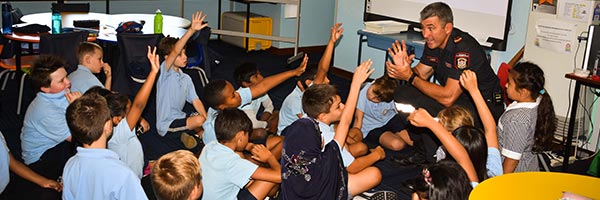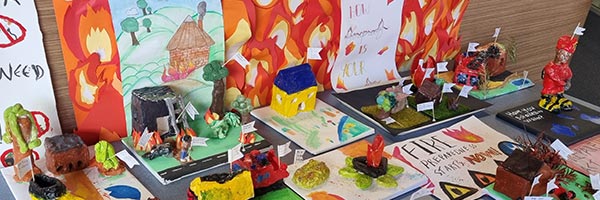Fire or life threatening emergencies: 000
Emergency Information: 13 3337
SES Emergency Assistance: 132 500
Disaster Resilience Education (DRE) helps children and young people build the skills and confidence to stay safe in emergencies. DRE encourages curiosity, supports wellbeing, and gives them a voice in planning and preparedness—at home, at school and in their communities.

Children and young people build resilience step by step:
See our Disaster Resilience Education Road Map for a simple guide to available resources and where DRE links with the WA Curriculum.

Consider local risks in the places where children and young people live, go to school and frequently visit.

When you visit someplace new, do you think about fire and natural hazards?
Situational and environmental awareness can be very important when it comes to fire and natural hazard risk.
Whether on holiday or moving to a new home, make sure everyone you’re with knows the risks. Discuss (and practice) an emergency plan.

Place children and young people at the centre of your emergency plans.
Practise your plans regularly so everyone knows what to do if faced with a fire or natural hazard emergency. Everyone can be given a job - even young children can prepare their own ‘emergency grab’ bag.
Encourage improvements to your plans. Children and young people are creative problem-solvers and could bring your attention to things you haven’t even thought of.
Emergency planning is a ‘life skill’ that children and young people are likely to continue to use into adulthood, helping to build safer communities in the long-term.
Click for more information about making emergency plans at home or school.

Prioritise fire safety and teach young children that ‘matches and lighters are tools, not toys’. Keep matches and lighters in a locked box or cupboard up high away out children’s reach.
Teach young children how to keep safe in the event of a house fire. Practise fire drills. Test your smoke alarms are working, crawl low under smoke and meet at your safe meeting place outside away from your home (this is often the letter box). Remind children to never go back inside for anything and never hide if the smoke alarm goes off.

All of DFES emergency helpers wear bright colours, reflective strips and protective boots, gloves and hats to keep themselves safe.
How can young children keep themselves safe?
Help kids be ready for emergencies. ABC Kids Helping Hands Disaster Resilience Toolkit has loads of tools to support families and early childhood teachers. Resources cover emergencies, bushfire, cyclone, earthquake, flood and severe storm.

The Triple Zero Kids' Challenge provides interactive activities for children to learn about emergency response and when to call 000.
It includes a Teacher’s Guide with lesson plans, an online safety game and ‘game show’ quiz. Quests provide children with essential skills to respond to fire, storm, flood, tsunami and other emergencies.

Be Safe in an Emergency gives simple safety messages to Pre-Primary to Year 2 children (age 4 to 8 years).
Each page uses puzzles, mazes, and fun challenges to help children learn about the emergencies that DFES manages or helps with.
There is also information for teachers and parents to help guide conversations about staying safe.
Children learn about:

Our Home Fire Safety program is designed to give children the key safety messages they need to prevent, prepare for and respond to a fire emergency in their home.
Teachers can access our DFES Teachers’ Guide to Home Fire Safety to find out how to include home fire safety in classrooms.
The Home Fire Safety Program includes:
On completing the program, teachers can print and present their students with a Junior Fire Safety Certificate.

Career firefighters can visit school students in metropolitan Perth and larger regional centres.
Some firefighters will deliver a fire prevention incursion to students from Years 5-8 as an add-on to the Bushfire Patrol program.
Contact your local metropolitan or regional fire station to book a free, 60-minute incursion.
Volunteer firefighters may also be able to visit your school. Reach out to your local service to find out more.

We offer free self-guided excursions to our Education and Heritage Centre in Perth.

Bushfire Patrol provides everything needed to deliver bushfire education in your classroom.
Students engage in place-based activities, with opportunities to draw on local expert knowledge.
Students develop a family bushfire plan and share their learnings with their families and school community.
Northwest Bushfire Patrol is designed for students living in Kimberley and Pilbara regions.

Our cyclone and flood resources can be used to deliver tropical and cyclone education for students in Years 4-7.
Resources aim to raise student awareness of cyclone and flood risk, whilst developing a range of skills to help them prepare for and respond to a tropical cyclone or flood emergency.
Students engage in place-based activities, with opportunities to draw on local expert knowledge.
Students develop a family tropical cyclone and/or flood emergency plan and share their learnings with their families and school community.


Would your students know what to do in an earthquake?
Western Australia has more frequent and stronger earthquakes than any other state or territory in Australia.
The Great ShakeOut drill takes less than 2 minutes. Demonstrate the drill to students or get them to research earthquake safety themselves. Use the audio files below to practise and run your drill.
Conduct an earthquake drill anytime in the school year or join the global Great ShakeOut on the third Thursday in October or World Tsunami Day on November 5.
Encourage students to share what they’ve learned with their family and friends.

WA is a vast state with multiple hazards. We encourage teachers and students to familiarise themselves with DFES’ hazard information to learn how they can keep themselves and their families safe.

Bushfires, earthquakes, severe storms and floods can happen almost anywhere in Western Australia and at any time.
It’s important to know and understand your risks.
Every person at any age can learn how to prepare for fire or natural hazard emergencies and know where to find correct and current information.
Emergency WA provides current alerts and warnings and daily fire danger ratings. It links back to the DFES website to find what to do before, during and after a bushfire, severe storm, tropical cyclone and flood.
Encourage children and young people to have and to practise emergency plans for hazards they are likely to experience in the places where they live or visit.

The Australian Institute for Disaster Resilience (AIDR) and Cool Australia have developed resources to help young people understand hazards and what can be done to reduce their risk.
Lessons aim to build resilience in young people, helping them to cope better before, during and after a natural hazard or disaster occurs.

All hazard information
Bushfire
Flood
Earthquake and Tsunami
Outdoor education

We all want our school communities to be safe. That’s why it’s important to include disaster resilience education and home emergency plans for students as part of your school’s emergency planning process.
School drills provide opportunities for teachers and students to share their own emergency plans with each another. Parents and carers can help by encouraging schools to include the broader school community in their school’s emergency plans and drills.
90% of WA is prone to bushfires.
If your school is in a bushfire prone area you should include bushfire education as part of your schools’ curriculum. You may also need to review your school’s bushfire plan.
Determine your school’s bushfire risk using the Bushfire Prone Areas Map.
Government schools on the Bushfire Zone Register are required by the Department of Education to have a Standalone bushfire plan in accordance with The Principal's Guide to Bushfire.
Please contact the DFES Bushfire Risk Management Liaison Officer at schools.bushfire@dfes.wa.gov.au for further assistance.
Organise a PD session with DFES
If you would like to find out more about PD opportunities for your school, university or education sector group, contact DFES Community Preparedness on 9395 9816 or email community.preparedness@dfes.wa.gov.au


Involve your children in emergency plans
Children as young as four years of age can be involved in your home’s emergency plans. When children are placed at the centre of emergency planning, they are likely to feel more confident about the possibility of facing a fire or natural hazard.
Get started by involving your kids in planning for bushfire survival. The guide Making a Bushfire Survival Plan? Involve your Kids! by Dr Briony Tower provides tips for parents on what children can do when making and practising bushfire survival plans.
Make emergency plans with your children and practise your plans:
The Scouts Australia SES Badge aims to give all Scouts the understanding and practical skills to help build their disaster resilience as they progress from Joeys to Ranger Scouts.
For more information on available activities, please contact Scouts or your local SES Unit.
A variety of educational resources on natural hazards and reducing disaster risk are available for download.
Our newsletter provides information about DFES incursions, excursions, programs and events, as well as upcoming PD sessions.
Recovering from a disaster can be made easier with the right tools. Here are some helpful resources to help children and young people affected by natural disasters.
Firefighters have an important role in our community to protect life and property. They do not have the capacity to attend schools or community events during the high threat bushfire season (summer to early autumn).
If you would like firefighters to speak to students at your school, class visits with focused messages or topics are preferable.
Please contact your local fire station to arrange a classroom visit.
All schools should have the A3-sized big book, Aaron’s Promise, in their library or resource room. Firefighters can read Aaron’s Promise and deliver age-appropriate messages to your students.
Please contact your local fire station to arrange a book reading.
Please contact DFES and direct your query to DFES Recruitment.
Please contact DFES and direct your query to DFES Recruitment.
Please email community.preparedness@dfes.wa.gov.au or call 9393 9816. We will contact your regional DFES District Officer to find out if they can assist.
Firefighters can deliver fire prevention and bushfire messages to students in Years 5-8. We encourage you to use Bushfire Patrol or North West Bushfire Patrol resources in your classroom.
Please contact your local fire station directly to discuss what you require and provide examples of the types of questions students are likely to ask firefighters.
Find out about excursions are available during school terms at the DFES Education and Heritage Centre here.
You may be able to arrange this via your local fire station. However, firefighters generally visit older students in schools, where possible.